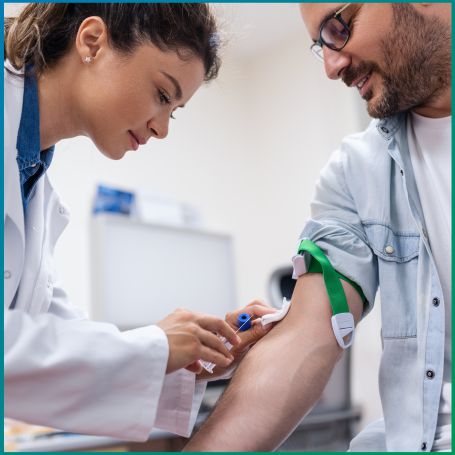
Theophylline is a xanthine derivative that has been used for decades to manage respiratory disorders.


It works by relaxing bronchial muscles, reducing inflammation, and increasing the efficiency of the respiratory system. Theophylline is available in various forms, including oral tablets, extended-release tablets, and liquid formulations. Despite its effectiveness, maintaining the correct dosage is essential, as both underdosing and overdosing can lead to ineffective treatment or adverse effects.
The theophylline test involves measuring the concentration of theophylline level in blood.
1] Sample Collection: A blood sample is typically drawn from a vein in the patient’s arm. The blood is usually collected in a tube that is sent to a laboratory for analysis.
2] Timing: Blood samples for theophylline testing are often taken at specific times, such as before the next dose of medication (trough level) or a few hours after ingestion (peak level). This helps to accurately assess the theophylline concentration in relation to the medication schedule.
3] Analysis: In the laboratory, the blood sample is analyzed to measure the concentration of theophylline. Various methods, including immunoassays and chromatographic techniques, can be used for this purpose.
4] Results Interpretation: The results are reported in micrograms per milliliter (µg/mL) and are compared to the therapeutic range established by the healthcare provider. The normal therapeutic range for theophylline is typically between 10-20 µg/mL, but this may vary based on individual factors and treatment goals.
Theophylline levels in blood can be categorized into several ranges:
1] Therapeutic Range: The ideal range for effective treatment is generally between 10-20 µg/mL. Within this range, theophylline is effective at managing respiratory symptoms without causing significant side effects.
2] Sub-Therapeutic Levels: Levels below 10 µg/mL may indicate that the dose is too low to effectively manage symptoms. This may result in persistent respiratory issues and inadequate control of the condition.
3] Toxic Levels: Levels above 20 µg/mL can be considered toxic. Symptoms of toxicity include nausea, vomiting, tremors, and palpitations. Severe toxicity may lead to more serious health concerns, such as arrhythmias or seizures.
4] Individual Variations: Factors such as age, liver function, smoking status, and interactions with other medications can influence theophylline levels. Adjustments to dosage may be necessary based on these factors.
At Diagnopein, we offer comprehensive, accurate, and timely diagnostic services, including the Theophylline test Pune. With our NABL-accredited labs, cutting-edge technology, and skilled technicians, you can be assured of reliable results every time. Get your results quickly, especially when time is crucial in detecting severe infections.
Competitive pricing without compromising on quality. Our team of experienced professionals ensures the test is conducted smoothly with minimal discomfort. We provide not just the Theophylline test results but insights into your health condition, helping you and your doctor make informed decisions about treatment. For more information call us at +91 9204 108108.
Typically, you should continue taking theophylline as prescribed until your doctor advises otherwise. However, always consult your healthcare provider if you have concerns or experience any new symptoms.
The theophylline test is generally safe with minimal risks. The primary risk is associated with the blood draw, which may cause minor discomfort or bruising. There are no specific risks related to the test itself beyond the usual risks associated with blood collection.
There are generally no special preparations required for the theophylline test. However, you should inform your healthcare provider about all medications you are taking, including over-the-counter drugs and supplements, as they can affect the test results.
The test involves taking a blood sample, usually from a vein in your arm. The sample is then analyzed in a laboratory to determine the concentration of theophylline in your blood.